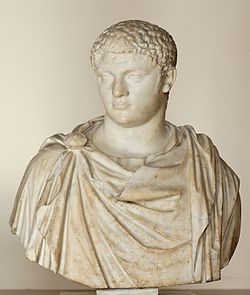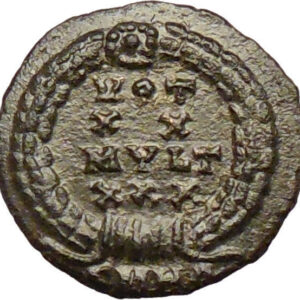|
Geta – Caesar: 198-209 A.D. and Roman Emperor: 209-211 A.D.
Silver Denarius 19mm (2.59 grams) Rome mint, struck 211 A.D.
Reference: RIC 74A (“without PP”); RSC 50a.RIC 74A (“without PP”); RSC 50a.
P SEPT GETA PIVS AVG BRIT, laureate head right.
FID EXERC TR P III COS II, Fides standing half-left, holding standard and legionary eagle, another standard behind her.
You are bidding on the exact item pictured, provided with a Certificate of Authenticity and Lifetime Guarantee of Authenticity.
Fides, the personification of fidelity or bona fides (good faith) in Roman paganism. The Greek equivalent of Fides is Pistis. She was one of the original virtues to be considered an actual religious “divinity”. Numa is said to have built a temple to Fides publica, on the Capitol, and another was built there in the consulship of M. Aemilius Scaurus, B.C. 115. She was represnted as a matron wearing a wreath of olive or laurel leaves, and carrying in her hand corn ears, or a basket with fruit.
Her temple on the Capitol was where the Roman Senate signed and kept state treaties with foreign countries, and where Fides protected them. The temple can be dated to 254 BCE. The original was said to have been built by Numa Pompilius, and a later building during the consulship of M. Aemilius Scaurus (115 BCE).
She was also worshipped under the name Fides Publica Populi Romani (“Public (or Common) Trust of the Roman People”). She is represented as a young woman crowned with an olive or laurel wreath, holding in her hand a turtle-dove, fruits or grain, or a military ensign. She wears a white veil or stola; her priests wore white clothes, showing her connection to the highest gods of Heaven, Jupiter and Dius Fidius.
Traditionally Rome’s second king, Numa Pompilius, was said to have instituted a yearly ceremony devoted to Fides Publica in which the major priests (the three flamines maiores-Dialis, Martialis, and Quirinalis) were to be borne to her temple in a covered arched chariot drawn by two horses on the 1st of October. There they should conduct her services with their heads covered and right hands wrapped up to the fingers to indicate absolute devotion to her and to symbolise trust.

Geta – Roman Emperor: 209-211 A.D.
| Caesar: 198-209 A.D. (under Septimius Severus and Caracalla) | Augustus: 209-211 A.D. (209-211 with Septimius Severus and Caracalla) (211 A.D. with Caracalla) |
| Son of Septimius Severus and Julia Domna | Brother of Caracalla | Brother-in-law of Plautilla | Nephew of Julia Maesa | Cousin of Julia Soaemias and Julia Mamaea |
Publius Septimius Geta (March 7, 189-December 26, 211), was a Roman Emperor co-ruling with his father Septimius Severus and his older brother Caracalla from 209 to his death.
Geta was the younger son of Septimius Severus by his second wife Julia Domna. Geta was born in Rome, at a time when his father was only a provincial governor at the service of emperor Commodus.
Geta was always in a place secondary to his older brother Lucius, the heir known as Caracalla. Perhaps due to this, the relations between the two were difficult from their early years. Conflicts were constant and often required the mediation of their mother. To appease his youngest son, Septimius Severus gave Geta the title of Augustus in 209. During the campaign against the Britons of the early 3rd century, the imperial propaganda publicized a happy family that shared the responsibilities of rule. Caracalla was his father’s second in command, Julia Domna the trusted counsellor and Geta had administrative and bureaucratic duties. Truth was that the rivalry and antipathy between the brothers was far from being improved.
Joint Emperor
When Septimius Severus died in Eboracum in the beginning of 211, Caracalla and Geta were proclaimed joint emperors and returned to Rome.
Regardless, the shared throne was not a success: the brothers argued about every decision, from law to political appointments. Later sources speculate about the desire of the two of splitting the empire in two halves. By the end of the year, the situation was unbearable. Caracalla tried to murder Geta during the festival of Saturnalia without success. Later in December he arranged a meeting with his brother in his mother’s apartments, and had him murdered in her arms by centurions.
Following Geta’s assassination, Caracalla damned his memoryy and ordered his name to be removed from all inscriptions. The now sole emperor also took the opportunity to get rid of his political enemies, on the grounds of conspiracy with the deceased. Cassius Dio stated that around 20,000 persons of both sexes were killed and/or proscribed during this time.
|











